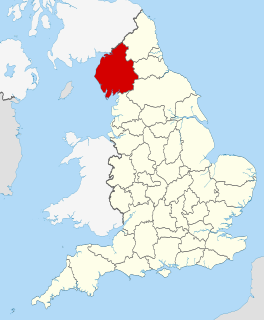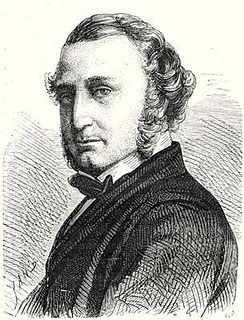
Thomas Russell Crampton, MICE, MIMechE was an English engineer born at Broadstairs, Kent, and trained on Brunel's Great Western Railway.

A Crampton locomotive is a type of steam locomotive designed by Thomas Russell Crampton and built by various firms from 1846. The main British builders were Tulk and Ley and Robert Stephenson and Company.

The Cumbrian Coast line is a rail route in North West England, running from Carlisle to Barrow-in-Furness via Workington and Whitehaven. The line forms part of Network Rail route NW 4033, which continues via Ulverston and Grange-over-Sands to Carnforth, where it connects with the West Coast Main Line.
Locomotives of the London and North Western Railway. The London and North Western Railway (LNWR) Locomotive Department was headquartered at Crewe from 1862. The Crewe Works had been built in 1840–43 by the Grand Junction Railway.

Workington railway station serves the town of Workington in Cumbria, England. The railway station is a stop on the scenic Cumbrian Coast Line 33 miles (53 km) south west of Carlisle. Some through trains to the Furness Line and from Sunderland stop here. It is operated by Northern who provide all passenger train services.
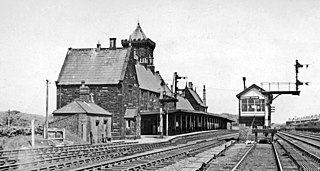
Maryport railway station serves the town of Maryport in Cumbria, England. The railway station is a stop on the Cumbrian Coast Line 27 miles (44 km) south-west of Carlisle. It is operated by Northern who provide all passenger train services. It is unstaffed and passengers must buy their ticket on the train or at an automatic ticket machine outside the platform. Step-free access to the platform is available; train running information is provided by digital information screens and timetable posters.

Parton is a village and civil parish on the Cumbrian coast, overlooking the Solway Firth, 1¼ miles (2 km) north of the town of Whitehaven. Formerly a port and a mining centre, it is now purely residential, benefiting from its location between the A595 trunk road and the Cumbrian Coast railway line.

The Solway Junction Railway was built by an independent railway company to shorten the route from ironstone mines in Cumberland to ironworks in Lanarkshire and Ayrshire.
The Cockermouth & Workington Railway was an English railway company which built and operated a railway between the Cumbrian towns of Workington and Cockermouth. The railway opened for service in 1847, and ran from the Whitehaven Junction Railway station at Workington to a station at Cockermouth near the bridge over the Derwent. A single-tracked line of eight and a half miles length, its revenue came largely from the transport of coal from the pits of the lower Derwent valley to the port at Workington for shipment by sea. The Marron extension of the Whitehaven, Cleator and Egremont Railway and the Derwent Branch of the Maryport and Carlisle Railway were both constructed to link with the C&WR and together give an alternative route for the northward movement of haematite ore from the Cumberland ore-field. The completion of the Cockermouth, Keswick and Penrith Railway made the C&WR part of a continuous through route between South Durham and the Cumberland orefield. These developments both improved the potential profitability of the C&WR and made control of it important to bigger companies wishing to maximise the iron-ore traffic over their lines: the C&WR was absorbed by the London and North Western Railway in 1866.
Seaton Iron Works was an iron works which operated between 1763 and 1899 under different titles and various owners. The site chosen was on the north bank of the River Derwent and was in the parish of Seaton, Cumberland. As well as making iron it also manufactured iron goods, tin plate and under control of Adam Heslop a foundry owner of Lowca, Cumberland was a manufacturer of stationary steam engines.
The Whitehaven, Cleator and Egremont Railway was an English railway company which built and operated a standard gauge railway in Cumberland, England intended to open up the hematite orefield to the south-east of Whitehaven. It opened for goods traffic in 1855 and for passenger traffic in 1857.
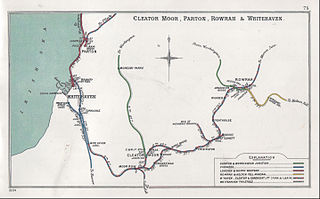
Cleator Moor had three passenger stations:
James I'Anson Cudworth was an English railway engineer, and was Locomotive Superintendent of the South Eastern Railway (SER). He served in this capacity from 1845–76. He is notable for designing a successful method for burning coal in steam locomotives without significant emission of smoke, and for introducing the 0-4-4T wheel arrangement to English railways.

Seaton railway station served the village of Seaton, near Workington in Cumbria, England.
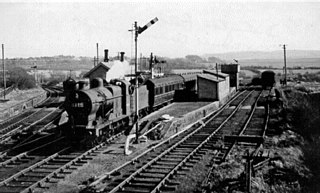
Distington railway station was opened jointly by the Cleator and Workington Junction Railway (C&WJR) and the LNWR and Furness Joint Railway on 1 October 1879. It was situated on the northern edge of the village of Distington, Cumbria, England where the C&WJR's north-south main line crossed the Joint Line's east-west Gilgarran Branch.

The Harrington and Lowca Light Railway was a short railway on the coast of Cumberland, which is now part of Cumbria, England.
